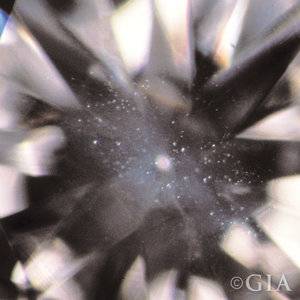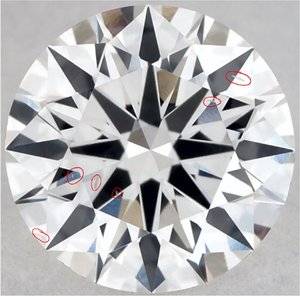- Joined
- Mar 2, 2013
- Messages
- 6,321
Reading through a recent thread, a diamond was being considered that - on its GIA report - noted a cloud as a clarity characteristic (in addition to a feather). And a kind PSer suggested asking the vendor’s gemologist to review the diamond to ensure the cloud doesn’t result in a negative impact, which makes sense. Follow-up post from the ‘buyer’ re: gemologist feedback is that the diamond “may appear cloudy”.
Here is the diamond:

And here is how GIA defines how a cloud may appear (image magnified of course): “Many tightly grouped pinpoints that might be too small to distinguish individually but together have a hazy appearance.” — http://4cs.gia.edu/en-us/blog/diamond-inclusions-defined/

So my question is - where on the diamond in question does this ‘cloud’ appear? I can see what I believe are the feather/s, but I’m trying to get better about identifying these things in the magnified images when they are present, but I don’t see squat for a cloud that resembles the GIA definition/image, unless I’m mistaking one of the ‘feather’-looking inclusions for the/a cloud.
I question this is because - if I/we cannot see it in the mega-magnified image - why would it not be relatively ‘safe’ to assume that the noted ‘cloud’ on the report (or any inclusion for that matter) would not impact performance/appearance? (Note: I’m not saying or suggesting “don’t ask a gemologist”). Would you - as a ‘more astute diamond buyer’ call this particular diamond ‘cloudy’?
Part of my thought process as well - in this particular case - is that perhaps the ‘buyer’ is missing out on an otherwise potentially great diamond (all other things being ‘in check’). I’d almost question if the gemologist actually looked at the diamond, or just noted that the GIA report said ‘cloud’, so responded that it “may appear cloudy”. Maybe his/her definition of “appearing cloudy” is that “you may see a couple tiny cloud inclusions” vs. “the diamond overall has a speckled/hazy look due to a/the clouds”. (I hope the difference I’m suggesting there is clear). Or maybe the question/answer depend on how the viewer/buyer defines a ‘cloudy appearance’. Obviously, I’m not a gemologist, but if I can’t see an overall “cloudy” appearance in a mega-magnified image, how the heck would I see one IRL when viewing the diamond in a normal setting & distance to the point it would impact appearance/performance, and how would it - in THIS case - make a diamond “maybe appear cloudy”?
GIA’s report checker is down so I can’t pull this diamond’s report to see the plot if there is one, so I blew the image up and circled what I could see, some of which might be a reflection of a feather/cloud inclusion, given their location & proximity.

Here is the diamond:

And here is how GIA defines how a cloud may appear (image magnified of course): “Many tightly grouped pinpoints that might be too small to distinguish individually but together have a hazy appearance.” — http://4cs.gia.edu/en-us/blog/diamond-inclusions-defined/

So my question is - where on the diamond in question does this ‘cloud’ appear? I can see what I believe are the feather/s, but I’m trying to get better about identifying these things in the magnified images when they are present, but I don’t see squat for a cloud that resembles the GIA definition/image, unless I’m mistaking one of the ‘feather’-looking inclusions for the/a cloud.
I question this is because - if I/we cannot see it in the mega-magnified image - why would it not be relatively ‘safe’ to assume that the noted ‘cloud’ on the report (or any inclusion for that matter) would not impact performance/appearance? (Note: I’m not saying or suggesting “don’t ask a gemologist”). Would you - as a ‘more astute diamond buyer’ call this particular diamond ‘cloudy’?
Part of my thought process as well - in this particular case - is that perhaps the ‘buyer’ is missing out on an otherwise potentially great diamond (all other things being ‘in check’). I’d almost question if the gemologist actually looked at the diamond, or just noted that the GIA report said ‘cloud’, so responded that it “may appear cloudy”. Maybe his/her definition of “appearing cloudy” is that “you may see a couple tiny cloud inclusions” vs. “the diamond overall has a speckled/hazy look due to a/the clouds”. (I hope the difference I’m suggesting there is clear). Or maybe the question/answer depend on how the viewer/buyer defines a ‘cloudy appearance’. Obviously, I’m not a gemologist, but if I can’t see an overall “cloudy” appearance in a mega-magnified image, how the heck would I see one IRL when viewing the diamond in a normal setting & distance to the point it would impact appearance/performance, and how would it - in THIS case - make a diamond “maybe appear cloudy”?
GIA’s report checker is down so I can’t pull this diamond’s report to see the plot if there is one, so I blew the image up and circled what I could see, some of which might be a reflection of a feather/cloud inclusion, given their location & proximity.





300x240.png)